In our vast oceanic world, a myriad of creatures roam the waters, each playing a unique role in the marine ecosystem. While many people may think of fish when they hear the term “sea animals,” the reality is much more complex. This article aims to categorize marine life, clarify common misconceptions, and help you understand which creatures qualify as sea animals.
Understanding Sea Animals
Sea animals can be broadly defined as organisms that primarily inhabit marine environments. This includes a wide range of species, from invertebrates to vertebrates. Let’s delve deeper into the classifications of these fascinating creatures.

Classification of Sea Animals
| Category | Examples | Characteristics |
|---|---|---|
| Fish | Sharks, Goldfish, Salmon | Gills for breathing, fins for swimming |
| Mammals | Dolphins, Whales, Seals | Warm-blooded, live births, breath air |
| Invertebrates | Octopuses, Jellyfish, Starfish | Lack a backbone, diverse body structures |
| Reptiles | Sea Turtles, Sea Snakes | Cold-blooded, lay eggs, live in both land and sea |
Identifying Sea Animals
When attempting to identify whether a creature is a sea animal, several criteria can help. A creature may be classified as a sea animal if:
- It lives primarily in saltwater environments.
- It has adaptations that are suited for aquatic life.
- It plays a role in the marine ecosystem.
The Role of Sea Animals in Ecosystems

Sea animals contribute significantly to the health and stability of oceanic ecosystems. They participate in various processes, including:
- Nutrient cycling
- Food webs
- Coral reef formation and maintenance
Comparison of Sea Animals
Let’s take a closer look at some common sea animals, comparing their features, habitats, and behaviors.
| Animal | Habitat | Diet | Lifespan |
|---|---|---|---|
| Dolphin | Coastal and open oceans | Fish and squid | 20-60 years |
| Great White Shark | Coastal waters | Fish, seals, and dolphins | 70 years |
| Sea Turtle | Open ocean and coastal areas | Sea grass and jellyfish | 50-80 years |
| Octopus | Coral reefs and ocean floor | Crustaceans and fish | 3-5 years |
Pros and Cons of Sea Animals
Pros of Sea Animals
- Vital for biodiversity and ecological balance.
- Provide food and resources for humans.
- Contribute to tourism and recreational activities.
- Invaluable for scientific research and medical advancements.
Cons of Sea Animals
- Some are endangered due to human activities.
- Can pose threats to humans (e.g., shark attacks).
- Pollution impacts their habitats and health.
- Overfishing can lead to ecosystem collapse.
Frequently Asked Questions
What are the main types of sea animals?
The main types of sea animals include fish, mammals, invertebrates, and reptiles.
Can all fish be considered sea animals?
Not all fish are sea animals. Some fish live in freshwater environments, while others have adaptations for saltwater.
Are dolphins considered sea animals?
Yes, dolphins are marine mammals and are considered sea animals as they live in oceans and seas.
What role do sea animals play in their ecosystems?
Sea animals play crucial roles in maintaining the balance of marine ecosystems, acting as predators and prey, participating in nutrient cycling, and supporting biodiversity.
How do human activities impact sea animals?
Human activities, such as pollution, overfishing, and habitat destruction, can significantly impact sea animals, leading to decreased populations and biodiversity loss.
Conclusion

Understanding which creatures qualify as sea animals is essential for marine conservation efforts. By recognizing the diverse range of species that inhabit our oceans, we can appreciate their roles in our ecosystem and the importance of protecting them for future generations.
As we continue to explore the mysteries of the sea, let us remember the interconnectedness of all marine life and the responsibility we hold in preserving it.